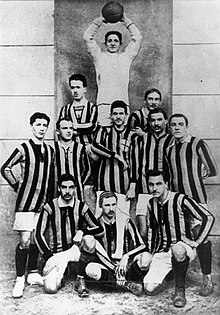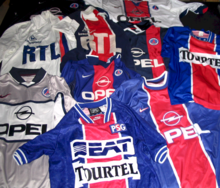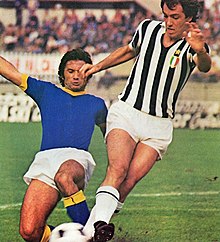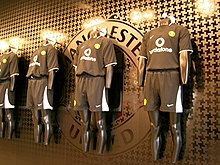Kit (football)
Footballers generally wear identifying numbers on the backs of their shirts. Originally a team of players wore numbers from 1 to 11, corresponding roughly to their playing positions, but at the professional level this has generally been superseded by squad numbering, whereby each player in a squad is allocated a fixed number for the duration of a season. Professional clubs also usually display players' surnames or nicknames on their shirts, above (or, infrequently, below) their squad numbers.
Football kit has evolved significantly since the early days of the sport when players typically wore thick cotton shirts, knickerbockers and heavy rigid leather boots. In the twentieth century, boots became lighter and softer, shorts were worn at a shorter length, and advances in clothing manufacture and printing allowed shirts to be made in lighter synthetic fibres with increasingly colourful and complex designs. With the rise of advertising in the 20th century, sponsors' logos began to appear on shirts, and replica strips were made available for fans to purchase, generating significant amounts of revenue for clubs.
Equipment
Basic equipment
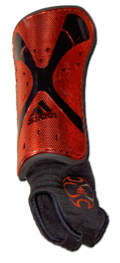
The rules set out the basic equipment which must be worn by all players in Law 4 (Players' Equipment). Five separate items are specified: shirt (also known as a jersey), shorts, socks (also known as stockings), footwear and shin pads. Goalkeepers are allowed to wear tracksuit bottoms instead of shorts.
While most players wear studded football boots ("soccer shoes" or "cleats" in North America), the Laws do not specify that these are required. Shirts must have sleeves (both short and long sleeves are accepted), and goalkeepers must wear shirts which are easily distinguishable from all other players and the match officials. Thermal undershorts may be worn, but must be the same colour as the shorts themselves. Shin pads must be covered entirely by the stockings, be made of rubber, plastic or a similar material, and "provide a reasonable degree of protection". The only other restriction on equipment defined is the requirement that a player must not use equipment or wear anything deemed dangerous to himself or another player.
It is normal for individual competitions to specify that all outfield players on a team must wear the same colours, though the Law states only "The two teams must wear colours that distinguish them from each other and also the referee and the assistant referees". In the event of a match between teams who would normally wear identical or similar colours the away team must change to a different colour. Because of this requirement a team's second-choice is often referred to as its "away kit" or "away colours", although it is not unknown, especially at international level, for teams to opt to wear their away colours even when not required to by a clash of colours, or to wear them when they are the home team. The England national team sometimes plays in red shirts even when their white standard kit does not clash with their opponent, as this was the strip worn when the team won the 1966 FIFA World Cup. In some cases both teams have been forced (or chose) to wear their second choice away kits; such as the match between Netherlands and Brazil in the 1974 FIFA World Cup where they wore white and dark blue rather than their first choice of orange and yellow, respectively; and the match between Netherlands and Spain in the 2014 FIFA World Cup where they wore dark blue and white rather than their home colors of orange and red, respectively. Many professional clubs also have a "third kit", ostensibly to be used if both their first-choice and away colours are deemed too similar to those of an opponent.
Most professional clubs have retained the same basic colour scheme for several decades, and the colours themselves form an integral part of a club's culture. Teams representing countries in international competition generally wear national colours in common with other sporting teams of the same nation. These are usually based on the colours of the country's national flag, although there are exceptions—the Italy national team, for example, wear blue as it was the colour of the House of Savoy, the Australian team like most Australian sporting teams wear the Australian National Colours of green and gold, neither of which appear on the flag, and the Dutch national team wear orange, the colour of the Dutch Royal House.
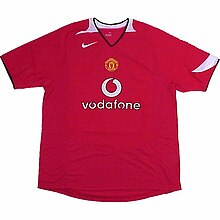
Shirts are normally made of a polyester mesh, which does not trap the sweat and body heat in the same way as a shirt made of a natural fibre. Most professional clubs have sponsors' logos on the front of their shirts, which can generate significant levels of income, and some also offer sponsors the chance to place their logos on the back of their shirts. Depending on local rules, there may be restrictions on how large these logos may be or on what logos may be displayed. Competitions such as the Premier League may also require players to wear patches on their sleeves depicting the logo of the competition. A player's number is usually printed on the back of the shirt, although international teams often also place numbers on the front, and professional teams generally print a player's surname above their number. The captain of each team is usually required to wear an elasticated armband around the left sleeve to identify them as the captain to the referee and supporters.

Most current players wear specialist football boots, which can be made either of leather or a synthetic material. Modern boots are cut slightly below the ankles, as opposed to the high-ankled boots used in former times, and have studs attached to the soles. Studs may be either moulded directly to the sole or be detachable, normally by means of a screw thread. Modern boots such as the Adidas Predator, originally designed by former Liverpool player Craig Johnston, feature increasingly intricate, scientifically aided designs and features such as air pockets in the soles and rubber "blades" on the sole rather than studs. The blades have been the subject of controversy as several top managers have blamed them for injuries both to opposition players and to the wearers themselves.
The rules specify that all players, regardless of gender, must wear the same kit, however in September 2008 the Dutch women's team FC de Rakt made international headlines by swapping its old strip for a new one featuring short skirts and tight-fitting shirts. This innovation, which had been requested by the team itself, was initially vetoed by the KNVB, Dutch football's governing body, but this decision was reversed when it was revealed that the FC de Rakt team were wearing hot pants (very short shorts) under their skirts, and were therefore technically in compliance.
Other equipment
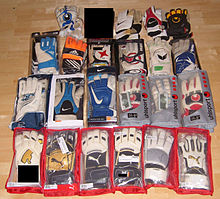
All players are permitted to wear gloves, and goalkeepers usually wear specialist goalkeeping gloves. Prior to the 1970s gloves were rarely worn, but it is now extremely unusual to see a goalkeeper without gloves. In Portugal's match against England in the Euro 2004 tournament, Ricardo drew much comment for deciding to remove his gloves during the penalty shoot-out. Since the 1980s significant advancements have been made in the design of gloves, which now feature protectors to prevent the fingers bending backwards, segmentation to allow greater flexibility, and palms made of materials designed to protect the hand and to enhance a player's grip. Gloves are available in a variety of different cuts, including "flat palm", "roll finger" and "negative", with variations in the stitching and fit. Goalkeepers sometimes also wear caps to prevent glare from the sun or floodlights affecting their performance. Players with sight problems may wear glasses as long as there is no risk of them falling off or breaking and thereby becoming dangerous. Most players affected choose to wear contact lenses, although Dutch player Edgar Davids, unable to wear contact lenses due to glaucoma, was known for his distinctive wraparound goggles. Other items that may be dangerous to other players, such as jewellery, however, are not allowed. Players may also choose to wear headgear to protect themselves from head injury, or to prevent further such injuries, such as Petr Čech and Cristian Chivu's use of rugby helmets, as long as it presents no risk to the safety of the wearer or any other player.
Match officials' kit

Referees, assistant referees and fourth officials wear kits of a similar style to that worn by players; until the 1950s it was more common for a referee to wear a blazer than a jersey. Officials wear shirts of a different colour to those worn by the two teams and their goalkeepers. Black is the traditional colour worn by officials, and "the man in black" is widely used as an informal term for a referee, although increasingly other colours are being used in the modern era to minimise colour clashes. The 1994 World Cup was the first in which FIFA dispensed with black kits for officials. Referees also sometimes have sponsors' logos on their shirts, although these are normally confined to the sleeves.
History
Victorian era
The first written evidence of a clothing item specifically dedicated to football comes in 1526, from the Great Wardrobe of King Henry VIII of England, which included a reference to a pair of football boots. The earliest evidence of coloured shirts used to identify football teams comes from early English public school football games, for example an image of Winchester College football from before 1840 is entitled "The commoners have red and the college boys blue jerseys" and such colours are mentioned again in a Bell's Life in London article of 1858. House sporting colours are mentioned in Rugby football (rule XXI) as early as 1845: "No player may wear cap or jersey without leave from the head of his house". In 1848, it was noted at Rugby that "considerable improvement has taken place in the last few years, in the appearance of a match... in the use of peculiar dress consisting of velvet caps and jerseys".

